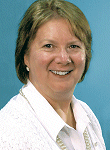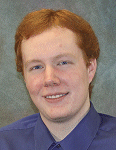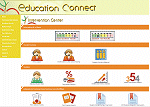THE Journal's 2008 Innovators :: 2
Lynda Gillespie
Chesterfield County Public Schools (VA)
 Staff development for the nearly 7,500
employees at Chesterfield County Public
Schools in central Virginia happens yearround.
But often, says Lynda Gillespie,
the district's director of technology,
"folks are trained in what they need in
the moment. We wanted to get them away
from looking at the now to start looking at the future."
Staff development for the nearly 7,500
employees at Chesterfield County Public
Schools in central Virginia happens yearround.
But often, says Lynda Gillespie,
the district's director of technology,
"folks are trained in what they need in
the moment. We wanted to get them away
from looking at the now to start looking at the future."
So seven years ago, Gillespie's team launched the Chesterfield
Informational Technology Expo (CITE), a daylong event dedicated to introducing
new technologies and sharing classroom success stories.
The conference, which typically takes place in mid-August, has
grown from 500 participants in that first year to about 1,300
attendees last summer.
The 2008 program included about 60 sessions and 50
workshops across every curriculum subject and operational
function in the district. Even the custodians and bus drivers
received attention. For the custodians, for example, there were
sessions on how to use a database to track work orders. This
year's conference also included an open house and "share fair"
to show assistive technologies, and a track specifically for
up-and-coming administrators such as assistant principals.
Says Gillespie, "If there's something new [in the district],
it's usually unveiled at CITE." In recent years, that has
included Edline, a resource to help parents
monitor their children's academic progress, and a new data
warehouse project.

At the district's annual late-
summer expo, Chesterfield
County educators get up to
speed
on some of the new
technologies they'll be
working with in the coming
school year.
Planning begins in January for the annual event.
Gillespie's managers head up committees to handle
registration, food, parking, and other event
details. The conference is usually held at the
largest and newest school in the district. Expenses,
which total about $10,000, consist of advertising
and printing programs. Gillespie estimates that 90
percent of the cost is covered by sponsor fees paid
by the 40-plus vendors that show their wares at the
event. In addition, the conference's catering
expense is covered through a wellness grant issued
to the district's benefits department.
Educators submit session proposals via an
online database built by a member of the IT staff,
and members of a program committee sift through
the submissions to determine the schedule. Most
of the presentations are given by teachers who have used a particular technology and, says Gillespie, "have
done exciting things in the classroom, but never have the
opportunity to share. It showcases them."
By the end of the day, says Gillespie, "there has been a
whole lot of networking, a lot of camaraderie. People are feeling
good, they're excited. They're learning new things. It's an
excellent way to begin the school year."
Jim Nelson and Kristen San Juan
Richardson Independent School District (TX)

Richardson kids use
graphing calculators.
When students in Texas' Richardson Independent School
District moved up from sixth grade to junior high, something
alarming would happen: Scores on the math
portion of the Texas Assessment of Knowledge
and Skills (TAKS) would fall. In
addition, the achievement gap between
the general student population and certain
segments of it, such as economically disadvantaged
students, continued to widen. To
figure out what remedies could be tried,
then Superintendent Jim Nelson reached out
to nearby Dallas-based Texas Instruments.
According to Kristen San Juan, then a
math teacher in the district, seventh- and
eighth-grade math classes were already
using TI-73 Explorer graphing calculators,
but they were simply handed out to teachers.
It was up to each teacher to figure out how to
apply the devices in the classroom. "There
was no instruction on what you could do
with them," San Juan says. "They have so
many valuable teaching functions, not just
10-key arithmetic."
Nelson believed there could be a systematic
approach to addressing students' needs,
so he and his leadership team went to work
developing a solution with Texas Instruments.
For all of 2004-2005, the district and
the computer industry giant collected and
analyzed data, eventually developing
MathForward. The program combines TI
technology with improved instructional
practices, continuous assessment, professional
development, and 100-minute "power
block" class periods.
MathForward was introduced at Lake
Highlands Junior High School, where San
Juan taught and was the math department
chair, and which has a large number of students
from low-income families who are on
the losing end of the achievement divide.
The program was soon expanded to all of
Richardson secondary schools. Since the
expansion, San Juan has taken on the role
of districtwide program
specialist, helping with
implementation. She has
seen the impact MathForward
has in the classroom,
and especially the importance
of the training
provided to teachers on
how to use the graphing calculators and incorporate them into
math lessons. Teachers can now monitor the work students are
doing on the calculators through TI-Navigator, a wireless
classroom collaboration system. When a student is struggling, the teacher can send help via a text message, or head to the
student's desk for one-on-one tutoring.
Were the devices removed from the lesson, San Juan says,
"the math would still be there, but the level of engagement and
discussion would decrease. It would go back to the same five
kids who would always answer."
Nelson left the district in 2006, but the program he helped
devise and launch is thriving. Average TAKS math scores for
students in seventh grade have risen 13 percentage points
since 2004, and eighth-grade scores have improved by 19
points. And according to Patti Kieker, deputy superintendent,
the district has successfully started closing the same-grade
distances between some student populations. As an example,
she notes, "Grade 7 students have moved from a 15-point gap
between all students and economically disadvantaged
students in 2004 to a six-point gap in 2008."
MathForward has also proven to be a boon to middle school
teacher retention, San Juan says. "There is a level of investment
at the beginning, but with enough patience and endurance the
results are huge. You'll see teachers say that they never want
to teach any other way again."
Kyle Lowry
Northview High School (CA)
 When administrators at Northview
High School in Covina, CA, wanted to
set up a learning intervention program,
they turned to former student Kyle
Lowry. Lowry, now a part-time project
coordinator at the school as well as a
full-time college student, had previously
created the Academy Book
Search, the school's web-searchable
database of books. Here he was being
asked to create something more ambitious: a system that
would manage scheduling and grading for a schoolwide peer
tutoring program.
When administrators at Northview
High School in Covina, CA, wanted to
set up a learning intervention program,
they turned to former student Kyle
Lowry. Lowry, now a part-time project
coordinator at the school as well as a
full-time college student, had previously
created the Academy Book
Search, the school's web-searchable
database of books. Here he was being
asked to create something more ambitious: a system that
would manage scheduling and grading for a schoolwide peer
tutoring program.
The result of that effort is the Intervention
Management System, located on the school's
educational resources website, Education Connect (see screen print).
Using the IMS, teachers refer candidates for tutoring
by submitting their student ID numbers, along with
what they need help in and relevant test scores.
The process of referring a student, Lowry estimates,
can take only 10 minutes.
To give students an extra period to study or
receive tutoring-- and teachers time to attend
their professional learning communities--
Northview switched to a seven-period model.
After students are recommended for tutoring,
they come to the library one period a day for a
week. They are tutored in groups by volunteer
student tutors, who have received three weeks of
training in library skills, instructional strategies,
and technology such as Thomson-Gale Cengage Learning research tools, the school's Academy
Book Search, and Blackboard learning tools.
 The staff and tutors are able to focus on helping students
because the IMS automates many arduous tasks, such as
producing the tutoring roster, maintaining progress reports,
and keeping track of statistics. The system uses the open
source MySQL database on the back end,
which performs a weekly batch process to pull schedules
from the district's student information system, Eagle
Software's Aeries, and plugs them into
Education Connect.
The staff and tutors are able to focus on helping students
because the IMS automates many arduous tasks, such as
producing the tutoring roster, maintaining progress reports,
and keeping track of statistics. The system uses the open
source MySQL database on the back end,
which performs a weekly batch process to pull schedules
from the district's student information system, Eagle
Software's Aeries, and plugs them into
Education Connect.
When the program initially started in 2006-2007, enrollments
were low. Lowry says that the bustle of the new year-- new
classes, PLC meetings-- got in the way. "Nobody likes change,"
he says. "But students started looking at intervention positively,
and the teachers picked up on that. That's when our enrollments
increased and teachers started to be more careful about the
types of assignments and quizzes they'd have the peer tutors
cover with the students."
Now participation averages about 120 students a week, though
sometimes enrollment spikes into the high 200s. The population
of student tutors has also risen, from about 40 to about 70.
The overall improvement score across all Northview students
who have received tutoring is roughly 21 percent, Lowry says.
That average is calculated based on the difference between
student assessment scores derived before and after tutoring.
The library has also seen more traffic from students, who are
increasingly using it as a resource.
"If you want intervention programs to work and be
responsive, you need to use a digital system," says Lowry.
"And it has to be more sophisticated than an Excel spreadsheet.
As far as pedagogy goes, teachers tend to know what
they're doing. The most difficult thing is handling the
logistics."
This article originally appeared in the 12/01/2008 issue of THE Journal.